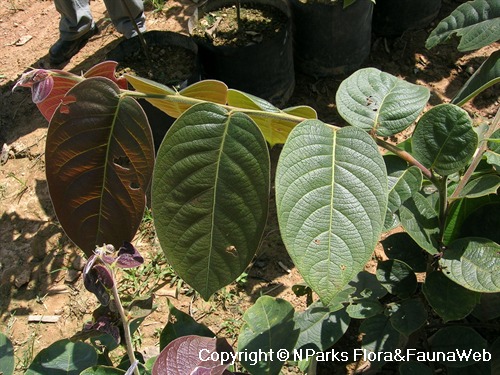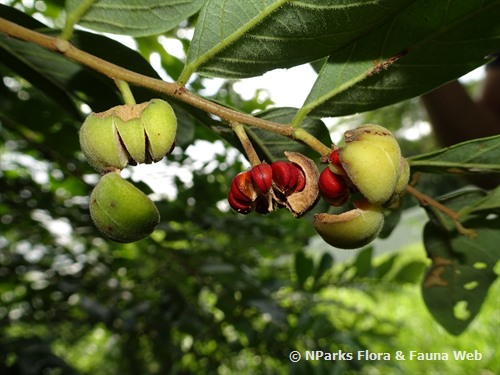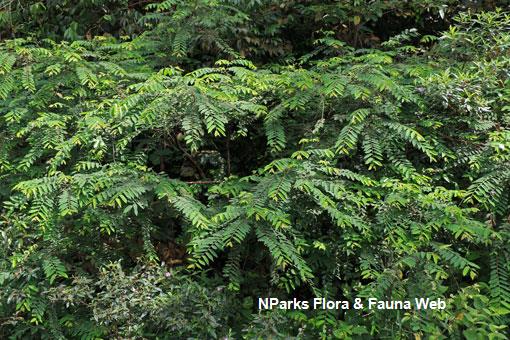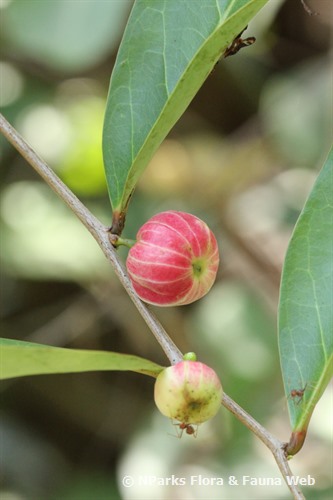
Back
Glochidion superbum Baill. ex Müll.Arg.
| Family Name: | Phyllanthaceae |
| Common Name: | Great-leaved Pin-flower Tree, Tebangau Gajah, Mayam, Nyam, Tebangau |
Name
Classifications and Characteristics
| Plant Division | Angiosperms (Flowering Seed Plants) (Dicotyledon) |
|---|---|
| Plant Growth Form | Tree |
| Lifespan (in Singapore) | Perennial |
| Mode of Nutrition | Autotrophic |
| Plant Shape | Irregular |
| Maximum Height | 23 m |
Biogeography
| Native Distribution | Thailand, Sumatra, Peninsular Malaysia, Singapore, Borneo, and Java |
|---|---|
| Native Habitat | Terrestrial (Primary Rainforest, Secondary Rainforest, Disturbed Area / Open Ground) |
| Preferred Climate Zone | Tropical, Sub-Tropical / Monsoonal |
| Local Conservation Status | Native to Singapore (Least Concern (LC)) |
Description and Ethnobotany
| Growth Form | It is a tree up to 23 m tall. |
|---|---|
| Foliage | Its alternate, stalked leaves have leathery leaf blades that are oblong or egg-shaped, dark green above, yellowish-green below, and 7.6–28 cm by 4.4–13 cm. Its midrib is covered with hair on both surfaces. New leaves are reddish in colour. |
| Flowers | Its alternate, stalked leaves have leathery leaf blades that are oblong or egg-shaped, dark green above, yellowish-green below, and 7.6–Its green-whitish flowers grow in clusters and are about 3.5 mm across. Its male flowers have stalks that are 1.2–1.9 cm long, while its female flowers are stalkless or have short stalks.28 cm by 4.4–13 cm. Its midrib is covered with hair on both surfaces. |
| Fruit | Its fruits are white-pink-purple, flattened, about 3 mm long, and grow in dense clusters. Its seeds have orange pulp. |
| Habitat | It grows in primary and secondary lowland forests, along roadsides, forest edges, on hillsides and ridges, up to 400 m altitude. |
| Associated Fauna | Its flowers are pollinated by insects, and fruits are eaten by birds. It is the host plant for the Colour Sergeant butterfly (Athyma nefte subrata). |
| Cultivation | It can be propagated by seed. |
| Etymology | Greek glochis, barb of an arrow; Latin superbum, superb or proud |
Landscaping Features
| Landscaping | It is suitable for parks and streetscapes. |
|---|---|
| Desirable Plant Features | Ornamental Foliage |
| Landscape Uses | General, Suitable for Roadsides, Parks & Gardens |
Fauna, Pollination and Dispersal
| Fauna Pollination Dispersal Associated Fauna | Bird-Attracting, Butterfly Host Plant (Leaves, Associated with: Athyma nefte) |
|---|---|
| Pollination Method(s) | Biotic (Fauna) |
| Seed or Spore Dispersal | Biotic (Fauna) |
Plant Care and Propagation
| Light Preference | Full Sun |
|---|---|
| Water Preference | Moderate Water |
| Plant Growth Rate | Moderate |
| Rootzone Tolerance | Moist Soils, Well-Drained Soils, Poor Infertile Soils, Fertile Loamy Soils |
| Propagation Method | Seed |
Foliar
| Foliage Retention | Evergreen |
|---|---|
| Mature Foliage Colour(s) | Green, Purple |
| Mature Foliage Texture(s) | Hairy / Hirsute, Leathery |
| Prominent Young Flush Colour(s) | Red |
| Young Flush Texture(s) | Hairy / Hirsute, Leathery |
| Foliar Type | Simple / Unifoliate |
| Foliar Arrangement Along Stem | Alternate |
| Foliar Attachment to Stem | Petiolate |
| Foliar Shape(s) | Non-Palm Foliage (Ovate, Oblong) |
| Foliar Venation | Pinnate / Net |
| Foliar Margin | Entire |
| Leaf Area Index (LAI) for Green Plot Ratio | 3.0 (Tree - Intermediate Canopy) |
Floral (Angiosperm)
| Flower & Plant Sexuality | Unisexual Flowers , Monoecious |
| Flower Colour(s) | Green - Light Green |
|---|
| Flower Grouping | Cluster / Inflorescence |
| Flower Location | Axillary |
| Flower Symmetry | Radial |
Fruit, Seed and Spore
| Mature Fruit Colour(s) | Pink, Purple |
|---|---|
| Fruit Classification | Simple Fruit |
| Fruit Type | Dehiscent Dry Fruit , Capsule |
Image Repository
Others
| Master ID | 1644 |
|---|---|
| Species ID | 2937 |
| Flora Disclaimer | The information in this website has been compiled from reliable sources, such as reference works on medicinal plants. It is not a substitute for medical advice or treatment and NParks does not purport to provide any medical advice. Readers should always consult his/her physician before using or consuming a plant for medicinal purposes. |




